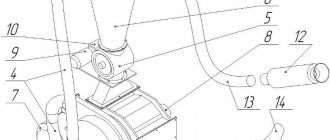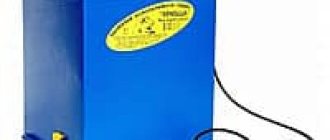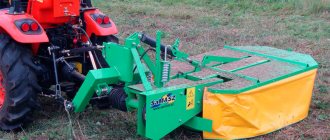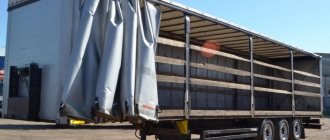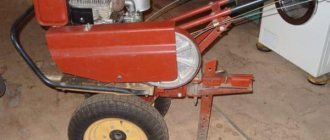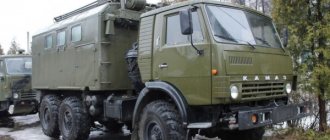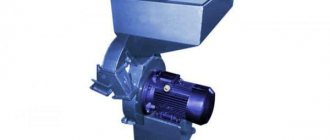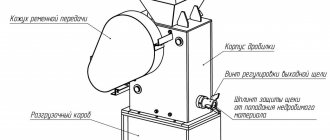What types of hammer crushers are there for feeding raw materials?
Based on the type of raw material supply, mechanisms are divided into double-rotor and single-rotor. The first type of device receives the substrate through a single hole, then the mass is passed into two sections of a mechanical mill, the units of which rotate in different directions.
Single-rotor crushers have many modifications. The units range from small in size to large industrial forms. Compared to multi-rotor mechanisms, single-rotor models have larger dimensions. In the second case, the loaded product enters directly into the mill cavity of the mechanism, so the devices are not prone to sticking of the processed powder mass.
Vertical crushers are used in the production of asbestos. The uniquely thought-out design ensures the release of the smallest substances.
Mechanism of operation. The loaded material is subjected to numerous blows from the first and then the second row of hammers. The degree of grinding is 1.3-1.8 mm, which is considered a low performance indicator of the device.
Reversible crushers or impact-reflective metal structures have a symmetrical frame. But in terms of service life, reversible units last much less and wear out quickly.
Popular crusher models
These devices are manufactured by different companies and have different characteristics, but their main distinguishing feature is the principle of operation and methods of their use. Below are some of the most popular types of shredders.
Crusher Molot – 400
The hammer crusher of the Molot - 400 series is designed for grinding dry materials. The Hammer 400 crusher is used in cooking (crushes sugar, spices, caramel), agriculture (grain, peas, rice), construction (slag, gypsum) and other industries.
Hammer crusher Molot 400
Main advantages:
- convenient sieve change;
- low noise;
- low level of wear of parts.
Hammer feed crusher DKM - 5
The DKM-5 crusher is designed for grinding feed and mineral additives.
Widely used in agriculture to supply livestock farms. The device can operate in three modes: automatic, manual and adjustment.
Advantages:
- simple design;
- easy installation;
- long service life;
- low energy consumption.
Wood waste shredder
The principle of operation is to grind wood waste. It is very popular in the sawmill and logging industry. Suitable for wood chips, wood, as well as branches, large twigs, etc. Allows the production of various materials: shavings, sawdust, wood dust. Used to avoid costs associated with the disposal of wood waste. In addition, the finished product can be used for further sale.
Multifunctional shredder (crusher) of wood waste and recyclable materials DU-2
The operating principle of the wood shredder and the functioning of the device are based on the principle of shredding wood waste, which takes place in several stages:
- purification of raw materials from foreign materials and transportation to the main production;
- grinding of raw materials;
- formation of the resulting product into fractions, removal of particles that do not correspond to general parameters;
- formation of finished products.
Operating principle of hammer crushers
The standard crusher set includes a 4-axis row with 64 or 96 hammers, a sieve with holes with a diameter of 3 to 12 mm. In addition to the unit, you can design an unloading area.
The substrate for processing is immersed in a hopper, where it is fed through a mesh by a magnetic separator. Here the mass is filtered and gets rid of metallomagnetic and large impurities. Then it goes into the mill box, the processed mass leaves the hopper through an opening into a separate vessel.
What are the differences between hammer crushers?
Vertical crushers differ in the type of processing and the purpose of the substrate. Both cheeks take part in the work process; their approach destroys hard rocks. The crushed mass is passed into a slot located at the bottom of the device.
Cone crushers differ from other models in their higher productivity and the complexity of the technical design. Grinding of the substrate occurs in the space of a ring-shaped vessel; it is based on a movable cone, which destroys the integrity of the incoming material. Crushers also differ in their mechanism of action, technical structure, duration of operation, and dimensions.
Flaws
Naturally, a hammer crusher, the price of which ranges from 1000 rubles and above, also has certain disadvantages:
1. The impossibility of grinding viscous materials and raw materials with a high level of humidity (more than 15%).
2. During operation, the noise level of this device is quite high.
3. Another unpleasant fact is the formation of a large amount of dust.
As you can see, the disadvantages are not significant compared to the advantages.
Hammer crusher device
The structure of the unit is quite simple. Under the metal frame of the device, there are parts:
- frame
- impact plate,
- safety clutch,
- coupling casing,
- rotor,
- electric motor
The electrical circuit of the device includes: electric motor, support frame, gearbox, gear couplings.
The stone hammer crusher is widely used in the construction industry for the production of crushed stone, and can also be used for crushing wood.
Principle of operation
MD crushes material of any degree of hardness by impact crushing.
Mechanism of action:
- Raw materials for processing enter through the hatch.
- After ignition, the engine rotates the rotor, which then transmits rotational movements to the hammers, which crush the substrate.
- The resulting mass flows through the grid (filter) into the prepared vessel.
- Pieces of the substrate are destroyed by the impact.
Where is it used?
Crushing of materials is most often used in the agricultural sector.
The grain hammer crusher is an important element in the production line of the highest quality feed products. Grains of cereals and leguminous crops require special processing using specialized equipment. (By the way, read this article about the features of feed choppers).
The hammer crusher combines such important qualities as high speed of operation, reliability of the main components and assemblies, simplicity of design, safety in operation and compactness.
The product obtained after crushing is of high quality, which allows us to produce complete feed of the highest quality with the addition of high-tech fortifying additives.
How to make a homemade hammer crusher with your own hands
A mini stone crusher should be made of durable material, and the knives and frame should be made of durable high-grade stainless steel.
You can make a crusher with your own hands using improvised materials from unnecessary metal products. The receiving hopper must have an oblong length. As an alternative, you can take a Kemerovo receiver or a small diameter pipe of 10-20 cm.
During the manufacturing process, an electric motor of 3000 rpm and a brake drum from a Muscovite will be useful. The knife can be made from a circular circle, then welded on a metal tube 5-7 cm long. Make a round filter (to transfer the smallest particles to another section) from an aluminum sheet. Drill 4mm holes. Fix the mesh tightly with bolts, distribute the knife so that it does not touch the walls of the device and is located directly under the lid. To limit the supply of substrate to the hopper, you can install a damper.
The second method of installing the mill: make six knives from a steel plate and attach them to the central part of the bottom according to the fan principle.
Before grinding the substrate, the knives must be sharpened each time.
Hammer crusher diagram
The technical composition of a hammer crusher includes several elements:
- fender,
- plate,
- rotor,
- part of the grate mesh,
- drive unit,
- rotating section.
Single rotor hammer crusher.
The shaft holds steel discs, between which hammers are fixed. In some units they can move vertically.
Bearings installed in housings serve as shaft support.
The substrate release plate has the form of a frame, the internal parts of which are fixed in steel plates.
The impact plate looks like a U-shaped beam. The inner part faces the rotor. Using a screw device, during operation the beam moves away and approaches the top of the hammers.
The grate includes a frame that is fixed on two pins and the grate itself.
The crusher frame is designed to assemble machine parts and components into a device.
Ways to upgrade
If the crusher operates at low power and has low productivity, the device needs to be reconstructed. Also, to increase production, you can install an additional saw and hammers into the structure.
There are situations when, after independently constructing the device, the internal mechanisms do not work correctly and pierce the frame of the crusher. In this case, it is also necessary to modernize the unit. To prevent this from happening, you must first try to make a frame of thick metal.
For ease of use, the device can be supplemented with a pneumatic machine and a second hole for the exit of crushed products. The degree of grinding depends on the residence time of the rock in the aggregate.
Parts for installing and developing a homemade crusher can be obtained from the nearest scrap metal collection point.
Surprisingly, the landfill contains very high-quality materials from the time of Stalin, which are not inferior to the rigidity and strength of German production. There are many modernized models for grinding wood and stone on the market.
Welded metal crusher
This model of grain crusher consists of:
- Frames,
- Drive,
- Shaft with cutting unit,
- Feeding hopper
- protective box,
- Calibration grid.
Frame and drive assembly
It is recommended to make the frame from a durable pipe with a wall thickness of at least 4.5 mm. You can also use a metal corner. If you plan to move the device, then a pair of wheels are attached to the frame.
The drive consists of a tension mechanism, a pair of pulleys and belts. All these materials are purchased in a specialized store. A petrol or electric motor is equally suitable for this crusher. The difference is that a gasoline engine makes the structure heavier, but provides more power. Electric is lighter and easier to maintain. If the shredder is planned for stationary use, then it is better to choose an electric motor. The minimum recommended engine power is 2 kW.
Shaft and bumpers
For manufacturing, a disk with a diameter of 35 to 65 cm is taken. The disk is put on the shaft, and the sleeve is welded to its outer wall. The cutter is equipped with knives turned on a lathe from a car spring. The length of each knife is equal to the length of the working cavity on the disk. The recommended blade sharpening angle is 30°. During sharpening, a backing is created at an angle of 2.5 -3°, which ensures better self-capture of the supplied raw material.
The bumpers are made removable. The width of the hammer mechanism of four chippers is 9 cm. Hammers are made from steel sheet 6 mm thick. The shaft with knives and hammers installed on it is mounted on double-row bearings.
Receiving hopper and housing
The protective housing is manufactured together with the loading hopper. The dimensions depend on the dimensions of the main working units (hammers, cutters, motor). The thickness of the housing walls must be sufficient to withstand loads and dampen engine vibrations. If the engine has a power of 2 kW, then it is recommended to make the wall thickness from 4 mm.
A window is made at the bottom of the housing for unloading the finished crushed material, which is closed with a sieve. The loading hopper can be made of thinner metal. The shape of the grain receiver is often cone-shaped or rectangular. For convenience, the hopper is equipped with a hinged or removable lid.
Imported mills
Judging by customer reviews, the Impact mill is the most popular all over the world. The success of this technique was guaranteed by its design, which has two annular chambers. The device has two grinding stages. First, the grain enters a hopper with hammers rotating along the smallest radius, where preliminary grinding is carried out. Then the initially crushed material “leaks” through the cells into the second chamber, where uniform fine grinding is carried out.
Another fairly popular specimen intended for fine crushing is a unit produced by Japanese. Its design feature is the presence of blades, which are dihedral wedges equipped with guide plates. They are located with packages of hammers, and when working they ensure fine grinding of grain products.
The main advantage inherent in all foreign-made equipment is reliability . Buyers are happy that if the operating and maintenance rules are followed, foreign-made hammer mills do not have to be repaired for a long time.
How it works
The main internal structure of hammer crushers:
- hammer drum;
- loading funnel;
- hammers;
- decks;
- sieve.
Closed Hammer Crusher
Large pieces are crushed using hammer blows and the product is quickly removed from the crushing chamber. When moving inside the drum, it does not close a circle. This type of crusher most often crushes chalk, granules and shells.
In closed type crushers, the loaded material moves around the circumference of the crushing chamber several times. Next, the product becomes quite loose, and crushing hammers come into play. The final result is obtained from the combined impact action of crushing hammers and grinding of the substance during friction in the crushing chamber.
Basically, hammer crushers are used for materials that have a small or medium safety margin. The hammer crusher does not process sticky and viscous materials.
Read an informative article about the types of wood shredders here.
Principles of separation
Double Rotor Hammer Crusher
Number of rotors:
- crushers with one working rotor;
- crushers with two working rotors.
Crushing hammer mounting type:
- crushers with freely moving hammers on hinges;
- crushers with rigidly fixed hammers.
Crusher shaft with free moving hammers
Rotor rotation:
- reversible crushers;
- wood crushers.
Read an interesting article about the types of crushers here.
Purpose of the KDU-2A feed crusher
The KDU-2 feed crusher is designed for grinding feed grain, corn cobs, cake and hay into flour and dirt, green feed, root tubers and silage into pulp, as well as for crushing other feed.
The crusher is used as a stand-alone machine or in conjunction with equipment for feed preparation departments.
Machine type:
- stationary,
- electrified,
- universal purpose.
The technical characteristics of the feed crusher are given in the table.
Table 1. Technical characteristics of the KDU-2A feed crusher
| Index | Meaning |
| Productivity, t/h: | |
| – when crushing grain; | 2,0 |
| – when crushing cake; | 3,0 |
| – when crushing hay; | up to 0.8 |
| – when grinding root and tuber crops; | up to 5.0 |
| – when chopping green mass | up to 2.0 |
| Electric motor power, kW | 30 |
| Electric motor rotation speed, min–1 | 1460 |
| Crushing drum: | |
| – diameter, mm; | 600 |
| — number of crushing hammers, pcs.; | 90 |
| — rotation speed, min–1; | 2725 |
| – peripheral speed of hammer movement, m/s | 71,3 |
| Knife drum: | |
| – diameter, mm; | 285 |
| — number of knives; | 3 |
| — rotation speed, min–1 | 600 |
| Overall dimensions, mm | 2800×550×3000 |
| Weight, kg | 1300 |
Features of Cone Crusher
The operating principle of the presented device is slightly different. That is, it has its own characteristics. For example, a cone crusher crushes raw materials using two truncated cones. When they rotate, the raw materials fall between their walls and are crushed. As you can see, there are no hammers here. The movable shaft is fixed in an eccentric sleeve.
As in the previous case, a cone crusher can crush almost any raw material that is not highly viscous. Quite often, such a unit is used for crushing very hard rocks. In this case, the fraction of the resulting material can be completely different.
How to use the device correctly?
First of all, you can equip your mechanism with special lining elements that will ensure long-term operation. They help avoid rapid erasure of parts of the device.
Before starting, the device must be warmed up. Try not to overload the hopper with raw materials. This may simply clog the rotor mechanism and lead to malfunctions. Also, before work, you need to select the fraction of raw materials that you need to obtain as a result.
Also, carefully inspect the inner chamber before starting. It should not contain any materials. First, the crusher must operate without raw materials. If there are no malfunctions, then you can load it with raw materials. However, only after the rotor reaches its maximum speed.
In order to collect already processed material, it is necessary to use an unloading conveyor. It is very important while the crusher is operating to pay attention to how hot the mechanism bearings are. If their temperature exceeds 40 degrees, you must immediately stop the unit and check for malfunctions.
If you urgently need to stop the crushing of raw materials, then you first need to stop feeding them and grind what is still left. Only after this can the mechanism be turned off.
How to choose the right product?
Before purchasing a crusher, you need to decide on the parameters you need:
1. Power and performance. It all depends on what kind of raw materials you will grind and where you will use the device. For home use, a small device with medium power is perfect for you; it is inexpensive. As for mining enterprises, a technically complex large apparatus is required that is capable of grinding a large amount of material per day.
2. Device type. In this case, you need to be guided by your preferences. In any case, the crusher will complete the task.
3. Naturally, you need to buy such devices only in specialized stores that have a license and warranty documents. At the time of purchase you have the right to test the mechanism.
An impact crusher is an effective product that can make your work much easier.
